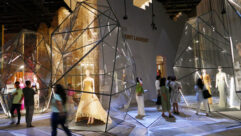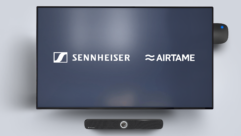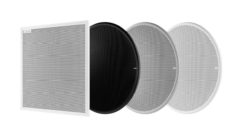USHERING IN A NEW ERA
Apr 1, 2000 12:00 PM,
Bruce Borgerson
The Millennium Dome, Great Britain’s spectacular celebration site,demonstrates future trends in audio systems.
The Millennium Dome is big. How big? Atlanta’s Georgia Dome is quite large,but you could fit a pair in side the Millennium Dome. The Eiffel Towerwould fit inside lying down, and Nelson’s Column standing up. The GreatPyramid of Giza could hide under the 20 acre (8 hectares) roof, whilefilling the dome’s interior volume would require 3.8 billion pints of stoutEnglish beer.
In more prosaic terms, the Dome is 1,050 feet (320 m) in diameter, 164 feet(50 m) high at the center, and supported by 12 steel masts of 100 m. Theroof fabric of PFTE-coated glass fiber is suspended on a web formed by 45miles (72 km) of steel cable. Constructed on a 181 acre (72 hectares) siteat Greenwich, the Millennium Dome hosted the New Millennium Experiencethrough December 31. On January 1, 2001, the dazzling shows will go dark,and all interactive exhibitions inside will be dismantled. The structurewill remain on site, however, dedicated to currently undetermined uses.
The Millennium experience
The Millennium Dome was built by the New Millennium Experience Company,(NMEC), a quasi-governmental entity created to commemorate the dawn of anew calendar era in a manner that “attracts, inspires, entertains, educatesand involves visitors and participants.” Total cost of the project is givenas 758 million pounds ($1.2 billion) with funding from national lotteryproceeds, corporate sponsorships and ticket sale revenues. NMEC projectedthat more than 12 million visitors would take part in the Experience beforeit closed on New Year’s Eve.
Inside the cavernous structure, 14 themed zones spaced around the perimeteroffer the visitor a mind-boggling variety of interactive experiences. Thezone names suggest the diversity of offerings: Learning, Work, Body, Play,Journey, Shared Ground, Living Island, Self-Portrait, Talk, Faith, Mind,Rest, Home Planet and Money. The central third of the Dome is the stage forthe Millennium Show, a high-flying spectacle quite unlike anything seenbefore. Jointly conceived by Mark Fisher and Peter Gabriel, the showpresents a breathtaking, high-flying love story that amalgamates elementsof theater, circus and dance with spectacular visual effects. Just outsidethe main dome, the Skyscape attraction screens a new “Black Adder” film(produced exclusively for the event) in two 2,500-seat cinemas, one ofwhich converts in minutes to a premier concert venue.
The Dome teams
The design of the dome structure was a joint effort by the Richard RogersPartnership, architects of record, and the consulting engineers of BuroHappold. Joint managing contractors for the massive project were Laing andRobert McAlpine, with acoustic consultants Symonds Travers Morgan assignedto provide effective separation of the hundreds of separate acoustic spacesunder the dome.
All audio systems for the Dome (and Skyscape) were designed and installedeither by NMEC’s own in-house production department or under direct NMECstaff supervision. NMEC hired audio system designer Roland Hemming to headup the audio side of the department in August of 1998. He took on thedaunting task of ensuring that all 57 of the Dome’s complex,inter-networked audio systems would be on line and functioning flawlesslyabsolutely no later than December 31, 1999.
To assist him in the monumental effort, Hemming tapped the skills of someof the U.K.’s top independent sound designers and assembled a uniqueconsortium of leading A-V firms (including Marquee Audio, Sysco, SystemSound, D J Willrich, Mike Weaver Communications, AudioCom, Canford Audio,Blitz Interactive, and Electrosonic Ltd.) to supplement NMEC’s own staff infulfilling the grueling installation schedule. All systems had to beinstalled, tested and commissioned within a 10 month window. At the peak ofconstruction, more than 200 people were working full time on audio systeminstallation.
Because of the massive scope of the project, contracts for installation andequipment procurement were usually put out for separate bids, and in manycases, the equipment quantities were so large that they were handleddirectly by the manufacturers. A partial list of major suppliers includesBSS Audio (signal distribution and processing), AKG (mics) JBL and Audax(loudspeakers), Allen & Heath and C-Audio (amps), Soundcraft (mixingconsoles), RTS (intercom systems), Soundtube (loudspeakers), DAR (diskrecorders), Hantarex (video and data monitors, LCD screens), NECTechnologies (plasma displays & portable LCD projectors), and Barco(projection and display technology). It is interesting to note that wellover 96 miles (160km) of fiber optic and copper cabling were used in thismassive installation, with 48 miles (80km) of fiber optic cable from Nokia,30 miles (50km) of alarm cable from Pirelli, at least 18 miles (30km) ofCat-5 from BICC, and many more miles (km) of mic and speaker cables fromKelsey, VDC and others.
Systems overview
It is probably safe to say that no other single, integrated audio system ofthis magnitude has ever been attempted, at least not under a single roof.In fact, the Millennium Dome could be compared to a modestly sizedInternational Exposition (World’s Fair) in scope, yet even the most recentexposition in Lisbon consisted mostly of separate systems in separatelocations with minimal integrated design. The Millennium Dome systems, incontrast, are actually related subsystems comprising an overall granddesign with a majority of audio systems interlinked throughout the site ona fiber optic backbone. The majority of show control systems wereElectosonic’s Eslinx range, using Electrosonic Easy+ software. Most of thecontrol systems had additional control by AMX/Panja hardware and softwareto allow for easier switching. Video servers from Do-Ray-Me, Matrox, andVisual Circuits were chosen by Richard Wathen of Ionus Visual ConsultantsLtd. (consultant to the Dome) as the source for all video routed around theDome, as opposed to the use of video tape or laser disc systems. In fact,the only place video tape or laser is used in the Dome is in the productionstudios.
A brief review of some numbers provides a glimpse into the scope of theDome’s audio systems. For example, each of the 14 themed zones uses severaltracks of prerecorded audio and some as many as 96. More than 600 audiotracks are used in all, with backups for the DAR recorders occupying 350 GBof hard disk space.
Taken together, the portable and installed systems employ 22 consoles, morethan 200 mics and more than 800 power amps (many multi-channel) drawing inexcess of 1 MW of electricity. The amps drive a complement of more than5,000 loudspeakers, ranging from the scores of small JBL Control Contractorseries loudspeakers employed throughout the site to the 92 HLA cabinetsproviding full-range surround sound in the back-to-back Skyscapeauditoriums.
Although loudspeakers and amps remain analog, virtually all signalprocessing, routing and distribution is accomplished in the digital domain.In this regard, the Dome represents by far the largest installation to dateof BSS Soundweb units with more than 800 units networked for use throughoutthe site. Many of the Soundwebs are housed in 12 massive highway rackslocated at network nodes spaced in a ring about the dome perimeter andconnected by fiber optic cable. More than 50 miles (81 km) of fiber cablewas laid around the site, supplemented by at least 30 miles (48 km) of CAT5cable and 40 miles 64 km) of voice alarm loudspeaker cable.
In addition to dedicated networks for each zone (each with two to 20Sound-webs), the Dome installation provides several site-wide digitalnetworks. One is a plug-and-play network for broadcast, which allowstechnicians to plug in mics or other sources at any one of dozens oflocations and then soft patch two-way signals through to the Dome’s twodedicated radio studios or the OB park. Another similar network allowsrouting of dome audio source to virtually any playback system. This networkis particularly useful for routing signals to the six hospitality suitesand for remote monitoring of various systems from the main sound controlroom. A third digital audio network converts all the Dome’s RTS intercomstations from two-wire to four-wire systems and then integrates intercomsignals into the dome-wide digital networks using Soundweb boxes. Digitalnetworking not only eliminates intercom buzz and noise, but it also allowssoft patching of various stations to reconfigure the system quickly fordifferent events.
Zone systems
Detailing the complete systems in each of the 14 zones would require ahefty book, but the five sample systems outlined here represent across-section of design approaches. The Mind zone pushes A-V technology tothe edge in a fascinating journey through the inner workings of the mind.Housed in gravity-defying architecture, Mind gives visitors the chance toplay mind games with robots, explore senses and perceptions and discoverhow perceptions can be misleading. One feature of the Mind zone is abaffling acoustic dislocation room, a sound-only exhibit using 24 JBL 4410Astudio monitors. As in all other zones, multi-track audio source playbackis via DAR OMR-8 hard disk digital recorders.
The Body zone is justly famous for an arresting exterior of two humanshapes in a soft embrace. After taking an escalator up through an arm,visitors explore advances in medicine, genetics and other sciences thatwill affect future health and physical development. The Body system employs96 tracks of audio playback distributed through the various interior spaces- skin, heart, womb, brain and laboratory. In each room, hidden JBL ControlContractor, Marquis and Sound Power series loudspeakers engulf the visitorin realistic surround playback of subtle inner body sounds. Also, SoundtubeRS-50 and ceiling-mounted CM-60s provide additional non-directionalplayback effects because of their unique 360 degree dispersion.
Home Planet first launches a spaceship ride for an astronaut’s-eye look atearth and swoops back to earth for a dizzying, close-up tour of planetaryecosystems. This zone is up on a revolving platform of 18 sectors, eachwith 15 seats, which move through the various experiences. Each seatcontains a pair of 3 inch (76 mm) Audax drivers housed in loudspeaker podsdesigned as ported enclosures for extended bass response. Audio signal foreach sector is routed from the video server via a Soundweb into Allen &Heath eight-channel amps. Half of the revolve area is one huge screen. Forthis sector, JBL Array series loudspeakers provide sound. Additional JBLControl 26CT and Control 19CST loudspeakers provide audio program for entryand exit areas.
Our Town Stage is a 500-seat live performance venue dedicated toperformances organized by local communities throughout Great Britain. Themain reinforcement system consists ofJBL Array systems augmented by smallerControl and Marquis series cabinets. New performances are presented dailywith a live feed to radio and television. This 500 seat venue is alsoequipped with an Ampetronic inductive-loop assistive listening system toaid those with T-coil hearing aids in the enjoyment of the program.
Finally, the dazzling Millennium Show in the Dome’s central area employs anovel reinforcement system to immerse up to 12,000 spectators in a stunningsurround sound experience. The central area is transformed entirely duringthe show because it literally builds up around the audience. A centercluster rises from the floor to a height of 40 feet (12.2 m), andadditional loudspeakers are built into moving stage elements, which meansthat alignment delays must be progressively altered during the show. Themain system (Funktion One self-powered systems using custom C Audio ampmodules) is augmented by numerous delay systems (including 48 custom JBLcabinets) and 12 clusters of effects loudspeakers for the surround channels.
Skyscape
The Skyscape cinema/concert venue is the only major Millennium Experienceattraction that is housed not under the Dome itself but rather in anadjacent structure. Unlike the Dome, Skyscape is a temporary structure thatwill be completely dismantled at the end of the year.
The rectangular Skyscape skeleton was built by Edwin Shirley Staging usingtruss components and portal arches. The walls were fabricated fromproprietary metal-faced, foam-filled panels. The roof is PFTE-coatedfabric, and both walls and roof are lined with a specially developedacoustic lining specified by consultants Symonds Travers Morgan. Isolationfrom exterior noise measures better than 20 dB, a remarkable figure for arelatively lightweight, temporary structure.
Skyscape houses two auditoriums, laid out back to back with a full-widthfoyer in between. Both cinema auditoriums seat 2,500, making them easilythe largest single screen rooms in Europe. One side of Skyscape isdedicated to the film showings while the other side doubles as an eveningconcert venue; added seating boosts capacity from 3,000 to 3,500, dependingon configuration. In the cinema mode, both rooms measure 171 feet (52 m)wide by 154 feet (47 m) long from projection wall to screen. On the concertside, an additional 1710 52 0 (52 m 16 m) area behind the screenaccommodates the needs of live production staging. Ceiling height variesfrom roughly 59 feet to 69 feet (18 m to 21 m), yet despite this enormousroom volume, the reverberation time RT subscript 60 barely exceeds onesecond.
Throughout the daytime hours, both cinema rooms operate simultaneously,though on a staggered showing schedule. The presentation is a 30 minute, 70mm film production based on the popular “Black Adder” television series.Entitled “Black Adder Back and Forth,” the fast-paced comedic adventureportrays Black Adder and his sidekick Baldrick traveling back through time,wreaking havoc at key moments in history.
The film sound track is somewhat unique in that instead of the standard 5.1channel format it uses six discrete channels – separate left and right rearsurrounds but no separate subwoofer track. Because all three front channelshave stacks of dedicated subwoofers, even deep bass sound can be presentedwith a surprising degree of directional control, particularly given thesize of the room and its exceedingly wide dimensions. The film’s soundmixers had the advantage of knowing the room dimensions and basic audiosystem design in advance, which allowed them to tailor some effectsspecifically with the large auditoriums in mind.
On the other end of the equation, the sound system designers had the luxuryof creating a system that was optimized for one specific film. An earlyversion of the soundtrack was available six months before opening, whichallowed playbacks throughout the system installation and commissioningprocess.
“We told the film sound people what we were going to use at the outset,”said Roland Hemming, head of NMEC’s sound department. “That way, they couldtake full advantage of what we had here. In fact, they even had ample timeto view the film here and go back for a remix, but that turned out to beunnecessary.”
Skyscape sound system design
The Skyscape systems were originally designed and specified by independentsound designer Chris Hey. In later stages of development, when Hey becomefully occupied with the Millennium Show, Mark Kelly of the NMEC sounddepartment and Andy Baker of AudioCom initiated some design changes. MarkBailey of JBL Europe consulted on final cluster configurations and alsohelped to commission the system using the JBL SMAART Pro computer softwareprogram.
To cope with the throw distances involved in the oversized auditoriums, JBLHLA high-Q concert reinforcement systems were specified for both the mainand surround channels. The front left and right flown clusters each containsix three-way 4895 top cabinets with four 4895 cabinets flown for thecenter channel. Stacks of six 4897 bass bins are placed left and right withfour bass bins assigned to the center channel. Three full-range HLA 4895systems on each side wall handle the left and right surround tracks whileeight more 4895s take care of the split rear surround tracks. A total of 92HLA systems are installed in Skyscape with power provided by 96 C-AudioPulse power amps (56 2×650 and 40 2×1100).
“We chose the HLA’s for Skyscape because we wanted good sound and becauseconventional cinema systems simply wouldn’t work,” Hemming said. “Thesurrounds were a particular problem due to the width of the seating area.With conventional surround speakers, people sitting to the far side wouldhear virtually nothing, but with the HLA we get the full surround effectthroughout the room.”
The cinemas were originally laid out with fan-shaped seating with openspace along the side walls. When a new, wall-to-wall seating layout wasapproved, NMEC’s sound designers realized the defined-coverage HLA systemswould leave a sonic shadow in the nearest rows. Accordingly, one JBL MS28downfill loudspeaker was appended to each of the side surround HLA cabinets.
“In this application, the HLA systems perform remarkably well,” Hemmingsaid. “It could best be described as a huge hi-fi cinema. We have an addedadvantage that, due to the width of the room, we could place the left andright clusters beside the screen instead of behind it. This way, there isno high frequency loss from the perforated screen.”
Hemming also noted how the power of the system, combined with the immenseroom volume, added impact to some scenes in the film.
“The sound of the dinosaur attack was pretty scary, and the big battlescene effects, with cannons firing behind you from both sides, addconsiderable impact to the overall experience.”
The cinema sound A chain originates with audio tracks on either DTS opticaltracks (Dolby EX encoded for L/R rear surround) or DAR OMR-8 hard disksystems. BSS Soundweb units in the projection room handle initial dynamicprocessing on a per-track basis, and then all tracks are multiplexed androuted to the backstage amp racks through a single CAT5 cable (at 24 bit/48kHz equivalent). There, additional Soundwebs are programmed to handle allcrossover signal and loudspeaker management tasks. There is also a fullyimplemented Williams Sound single channel infra-red assistive listeningsystem available for use in the Skyscape to supplement the sound system forthose who require it.
Instant concert hall
Converting one side of Skyscape into a first-class concert venue is asimple procedure. The cinema screen is hoisted up flat against the roof,and the HLA center cluster top cabinets are lowered on chain hoists androlled away along with the floor stacks of bass bins. With a few mouseclicks, the Soundweb signal routing system switches from cinema to concertmode, adding a feed from the mixer to the four JBL Venue series VS 2110downfill loudspeakers over the stage front area.
“The sound changeover from cinema to concert takes only 20 minutes,”Hemming said. “This allows us to run the cinema showings all day then setup quickly for a separately ticketed event in the evening.”
Skyscape’s FOH mix position is anchored by a Soundcraft Series 5 mixingconsole with 48 mono and four stereo inputs, full LCR panning and a 16 10output matrix. The processing racks are filled with enough gear to satisfythe most demanding concert mixers, including Focusrite Red 7preamp/dynamics processors, BSS DPR series compressors and gates, DrawmerDS-201 gates, Yamaha SPX-990 and D5000 and TC Electronic 2290multi-effect/delay devices, Lexicon 480XL and PCM91 reverbs and an EventideH300SDE harmonizer.
The monitor system uses another 48-input Soundcraft Series 5 desk inmonitor configuration. Racks of additional BSS, Yamaha and Lexiconprocessors tailor the signal before sending out to the vast array ofmonitor loudspeaker systems, including 30 JBL wedges (Array, MS and SPseries), four JBL Array drum/side fill cabinets, four HLA side fills and 20Galaxy Hotspot mini-monitors.
The wide assortment of available mics covers every performance requirementfrom symphony orchestra to hard rock, with an ample stock of virtuallyevery AKG condenser in production including C series, D series and blueline models. Additional dynamic and condenser models such as Shure SMseries, Beyer M88, Electro-Voice RE-27 and Sennheiser E609 and MD421 roundout the collection with an assortment of BSS AR133 direct boxes availableas needed.
Broadcast audio of Skyscape concerts is accommodated by a 48-channel stagebox that employs BSS MSR-604II active state splits for an adjacent audiotruck. The Soundweb/fiber network also provides a 32-channel send andreturn direct link to the main OB park plus an additional eight-channelsend and return into the Dome network for soft patching anywhere on thesite.
Whether in cinema or sound reinforcement mode, communications around theSkyscape are accomplished via a six-channel RTS communication system usingRTS BP325 beltpacks and Beyer headsets with numerous sockets installedaround the venue.
Sir George on site
The Skyscape venue hosted several rock and pop concerts in its first monthsof operation, but perhaps the most demanding test of house systemcapabilities came late in February with the “Voices of Promise” concert.Produced by Sir George Martin with all proceeds benefiting the Children’sPromise charity drive, the concert featured the 22 finalists (from 7,000entrants) in a nationwide search for original compositions by Britishschool children.
The technical demands for the evening were extraordinary. The mix wouldencompass a 57-piece orchestra, a band, and children’s choirs with a widerange of vocal timbres. A revolving stage further complicated matters, andthere would be no time for a full run-through. To handle all the extrainputs, one of the Dome’s roving Sound-craft K3 consoles was brought in andassigned orchestra submix duties while the resident Series Five took careof the wireless mics, band inputs and mixes to Genex recorder and videotapemachines. Despite the inherent hazards of working with young amateurperformers, the concert proceeded smoothly, the sound was flawless, and SirGeorge Martin was observed smiling broadly.
“The Skyscape’s HLA system works incredibly well for concerts,” said RolandHemming. “Nobody has any hesitation about using the equipment provided. Wehave yet to hear a request from someone who wants to bring in his own deskor his own racks and stacks.”
Despite all the sound deadening material, Hemming believes Skyscape issufficiently live to provide good ambient sound in most rock and popconcerts. He does, however, anticipate using the existing surroundcapabilities for adding extra hall ambient effects in a forthcoming concertfeaturing a small orchestra.
“All the surround channels come up on the mixing desk and on the Soundwebs,so it will be easy to implement,” he said.
Surround sound may be an added attraction for other Skyscape programs,which may be added later in the year. “We have word that HDTV projection ofsome events is being considered,” said Hemming. “Because these events arenormally broadcast in Dolby surround, we would certainly implement it hereas well.”
All’s well that begins promptly
Two months after opening, Hemming and his staff were still busy with theinevitable re-tweaking, reconfiguration and operational issues that go witha complex. Nevertheless, Hemming could look back on the preceding 18 monthswith some satisfaction and relief.
“The amazing thing about the Dome project,” he said, “was that it was sucha huge project, one in which everybody involved had a big enough empire tobuild. Yet there was no fuss because the single objective was to get thejob done on schedule.”
He noted that the level of cooperation was high throughout the process withconsultants, installers, suppliers and manufacturers all sharing ideas andinformation.
“Quite often, one contractor would say to another, normally his competitor,`Oh, we found a way around that. I’ll send one of my team around thisafternoon and show you what we did.’ I have never before experienced thislevel of cooperation and support in our industry, but we all knew this wasthe only way we could get the job done. We had to be ready on time, and Iwas going to make sure that sound wasn’t going to be the only thing thatwas not ready.”
Fortunately, on the evening of December 31, the Dome sound systems wereready and performed flawlessly. Prime Minister Tony Blair was observedsmiling broadly. The Queen was observed, shall we say, apparently judgingall to be satisfactory.
The problem involved providing an image for 12,000 guests in the centralarea of the Millennium Dome. That was the challenge faced by Jennie Page,chief executive of NMEC.
“Our aim was to create a unique and unforgettable celebration of themillennium that could be shared by everyone,” she said. “With a perfectlyorganized audiovisual show and a combined cast of over 900 performers usingmusic, dance and carnival to move and inspire, we believe we did just that.”
To accomplish the display of these dynamic images, the NMEC selected thehighest resolution DLite 7 Daylight display LED screens, manufactured byBarco and provided by Show Presentation Services. For the Dome’s openingcelebration, two giant DLite 7 Daylight displays in excess of 1,076 ftsuperscript 2 (100 m superscript 2) were erected to broadcast scenes of thebreaking millennium across Europe and to screen the special millennium showimages in the central area. Combining high light output, extremely wideviewing angles and a visual resolution of 0.25 inches (7 mm), the DLite 7offers color accuracy and uniformity unsurpassed in an outdoor display.Smaller Barco Dlite 7 displays are also being used at the dome entrance andthe admissions line. In addition, Barco has provided more than 60projectors from its new ELM Series DLP and high-performance 6300 series LCDprojection systems for use in areas throughout the Dome.










